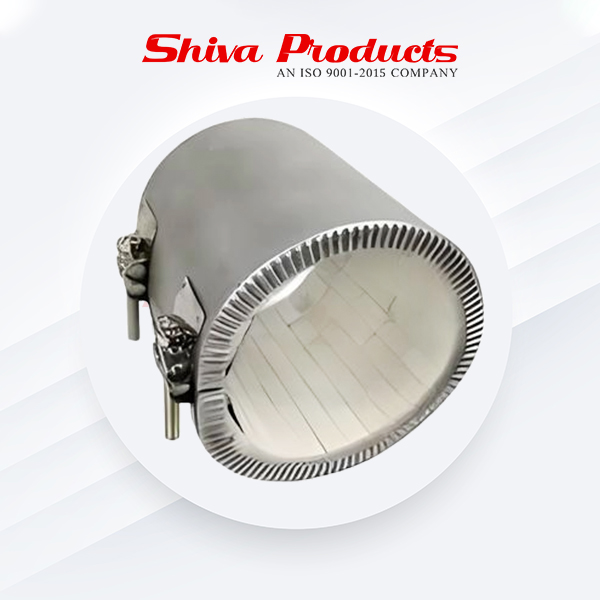Ceramic band heaters have spirally wound inner resistance coils that are evenly spaced through interlocking, insulated ceramic "tiles." The ceramic core, or "mat" of tiles, is protected by a stainless steel sheet with serrated edges. The notched edges fold over to attach the ends, and the tiles are protected by an inner liner that must be removed after installation.
The Ceramic Band Heater's combined assembly creates a flexible heating system with effective conduction and radiated heat transmission. The ceramic band's heat is generated by its inner coils, which conduct heat at high temperatures. The heated coils uniformly transmit heat to the ceramic tiles, which radiate energy into the barrel.
Ceramic bands are available in a variety of styles, ranging from traditional to customized. When selecting a ceramic heater, choose one that best suits your wattage needs, since this will decrease the frequency of cycling and temperature overshooting, increasing the heater's life. When replacing a non-insulated heater with a band heater, the total operating wattage is reduced by around 15-20%.
Features of ceramic band heaters:
1. Quick heat transmission, even heat, and consistent performance.
2. Constant temperature without leaking allows for energy savings, and the exterior cover is safe to touch and not hot.
3. Ceramic strips have a power output that is 0.5-1.5 times higher than typical.
4. High-temperature heat wire, with quicker and even heating, high temperature stability, and other properties, may be used for a long time at 600-800 ℃.
5. long life, because the raw material is aged slowly at high temperatures.
Where Are Ceramic Band Heaters Used?
You’ll find band heaters in places where high, steady heat is needed—especially in the plastic, rubber, and packaging industries.
For example:
- In injection molding machines, to melt plastic so it can be shaped
- In extruders, to keep materials flowing smoothly
- In pipe heating, to prevent the material inside from cooling or clogging
Why Choose a Ceramic Band Heater?
These band heaters can withstand far higher heat, usually up to 1200-1400°F (650-760°C). The ceramic segments used in these heaters are good insulators. However, because ceramics can transfer heat, they also retain heat, making temperature management more challenging. This can lead to process issues, especially in the plastics sector, due to overheating. They typically cost a little more than mica band heaters.
Ceramic band heaters are manufactured by coiling a resistive wire and inserting it into the holes of ceramic pieces to provide electrical insulation. The ceramic assembly is bonded to a sheet metal cover and shaped into the required shape.
These band heaters use infrared radiation to transmit heat from the air to the surface to be heated, needing no physical touch. The interior temperature of ceramic bands is restricted to around 900°C.
You have choices for band/nozzle heating. Depending on your application, you may choose which type of insulator to employ. If you need low-temperature heat and want to save money, consider using mica, the most prevalent form of insulation in many sectors. Ceramic is your finest mid-temperature option. Finally, if you want a continuous higher-temperature band heater, use the mineral-insulated band heater.
Ceramic band heaters have performance advantages
1. With windings, such as heating containers or pipes, it may be twisted into an arc or circular cladding and heated on the surface, such as heating large parts, partially recycling, packing difficult shapes, and large-area workpieces can be made flat. Furthermore, it is useful for heating a variety of geometric forms.
2. It is possible to achieve a high operating temperature, rapid heating, high thermal efficiency, zero pollution, uniform and precise heating, and automatic control.
3. High mechanical strength, excellent heat preservation, direct contact with the heated item, and extended service life.
4. Easy installation and maintenance, cheap cost of operation; even if the internal heating material is destroyed, the exterior ceramic components may be reused.
Conclusion
Ceramic band heaters are a viable option for industrial applications. Understanding their operating principles and following the installation, operation, and maintenance requirements described in this article will guarantee that your heater performs optimally and lasts as long as possible. Remember to examine your heating requirements, select the appropriate size and power rating, and emphasize safety throughout installation.
Frequently Asked Questions
How to Install a Ceramic Band Heater?
Clean the surface, position the warmer, secure it, and connect the electrical cabling. Consider utilizing the proper equipment and materials, and always emphasize safety by shutting off the power supply before beginning the installation.
What are the challenges you might face during the installation of band heaters?
Installing a heater might be challenging due to uneven surfaces or restricted access to the region. In such instances, it is advisable to have alternate installation methods or to seek expert assistance. Ensure appropriate insulation and take steps to protect the heater and its surrounding components.
How do I keep my ceramic band heater maintained?
Regular maintenance is critical to the longevity of your band heater. This might involve cleaning the heater, testing electrical connections, and looking for signs of wear or damage. To guarantee proper maintenance, follow the manufacturer's recommended intervals and methods.
How to increase the lifespan of the band heater?
To extend the life of your ceramic band heater, it's important to maintain and examine it on a regular basis. Emphasize the necessity of regularly cleaning the heater, replacing worn-out parts, and preventing extreme temperature changes. Encourage consumers to follow manufacturer recommendations and seek expert assistance when needed.






Comments